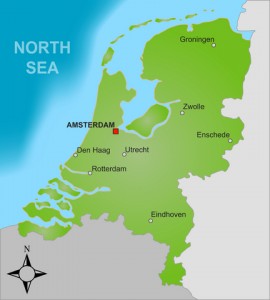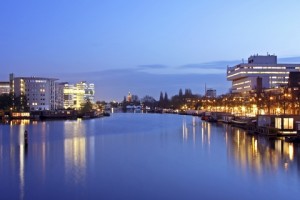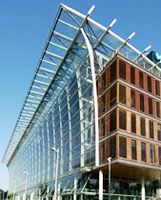
[Updated Oct 2020] A guide to serviced offices and office space for rent in Amsterdam as well as general information that may be useful if you are thinking of renting office space in the city.
For further offices information or to search for offices for rent in Amsterdam just click. Or contact us for any other query.
History
Few European cities have the aura that Amsterdam does or history as storied as the Dutch capital. And while its founding is relatively recent compared to many other Dutch cities, its importance grew incredibly quickly. The city started life in the 12th century as a small fishing village on the river Amstel. Its name literally means ‘dam on the river Amstel’. It was in the 14th century that the city started thriving, mostly off a brisk trade with the powerful Hanseatic League, a guild of merchants that ran trade in northern Europe for centuries. The Netherlands gained its independence from the Spanish Empire in the 16th century, and with this Amsterdam became known as a place of religious tolerance, which also helped its status as a centre of trade. Many Jews from Spain and Huguenots from France moved to the city from Spanish-controlled areas of Europe. In the 17th century, Amsterdam became the wealthiest and most progressive city in the world. This period is known as the Dutch Golden Age. Ships from Amsterdam sailed to all corners of the globe, including Africa, North America, India, and Brazil. The Dutch East India Company acquired territories abroad which later became Dutch colonies. Amsterdam was the financial centre of the world, and in 1602 the city opened the world’s first stock exchange. However, in the 18th and early 19th centuries, wars with England and France took a toll on Amsterdam and the city lost its status as Europe’s foremost trading city. The city’s fortunes experienced an upturn in the late 18th century when the Amsterdam-Rhine Canal was built, which gave the city access to the Rhine. The North Sea Canal, which connected the city to the North Sea, also dramatically improved trade with the rest of the world. The Netherlands stayed neutral in WWI but was invaded by Germany in WWII, and the city suffered a shortage of food and fuel. After the war, much of the city was in disrepair and a massive campaign of regeneration, and more importantly, restoration, was started. Today Amsterdam has managed to preserve many of its old buildings and streets, and through this, the old feel of the city centre. Today the city centre is a protected area and in 2010 many of the city’s canals and neighbourhoods were added to the UNESCO World Heritage List.
Economy
Amsterdam was recently rated as the fifth-best city in Europe to locate an international business, only outranked by London, Paris, Frankfurt and Barcelona. The city is the financial centre of the Netherlands and a plethora of large corporations and banks are headquartered in the city, including ING Group, Ahold, Royal Bank of Scotland, Akzo Nobel, Heineken International, and Philips. Many international companies have chosen to base themselves in nearby Amstelveen, where unlike Amsterdam one can fully buy land, instead of only leasing it. The Zuidas district, in the south of the city, is the becoming the new business and financial hub, though it is still largely under construction. The area surrounding the Amsterdam Sloterdijk railway station is a popular place for businesses, as is the Financial District surrounding Amsterdam Arena.

Tourism & Architecture
Amsterdam receives almost five million visitors every year, making it one of Europe’s most popular tourist destinations. The majority of tourists are from Europe or the US. They come to explore Amsterdam’s rich history and its stunning architecture, built around the city’s famous canal system. Many of Amsterdam’s buildings are from the 17th century, built in the immediately recognizable Rennaissance style of architecture. This style is directly attributable to the famous Dutch architect Hendrick de Keyser. The Royal Palace on Dam Square is always popular with tourists, as are the old merchants’ houses lining the canals in the old city centre. Many also visit the famous Anne Frank house, the former residence of the perhaps the most famous victim of the Holocaust. But Amsterdam is equally as famous for its bawdy red light district and coffee shops selling marijuana. Known as De Wallen, Amsterdam’s red-light district is perhaps the most well known in the world. It is notorious for its legalized prostitution, which takes place in small one-room cabins in a network of alleys in the heart of Amsterdam’s oldest part near the Oude Kerk church. The city’s coffee shops are scattered around the centre of the city and offer visitors their choice of marijuana, hashish, or simply fruit juice or coffee or tea. Those seeking more cultural pursuits usually visit one of the city’s famous museums located on Museum Square, such as the Van Gogh Museum or the famous Rijksmuseum.
Transport
The Dutch are famous for being avid bicycle riders and this is obvious in Amsterdam from the heavy bicycle traffic throughout the city. Amsterdam is one of the most bicycle-friendly cities in the world and there are many convenient bike lanes and bike racks provided. Driving is discouraged in the city centre and parking is exorbitantly expensive. Most of the city’s public transport is based on bus and tram lines. Currently, there are 16 different tram lines with four new ones under construction. Water taxis and buses are also a popular form of transport with tourists. The city has ten train stations, five of which are intercity stops. The Amsterdam Centraal station has international connections to all over Europe. For air travel, Amsterdam is served by Schipol Airport, which is about 20 minutes by train from Amsterdam Centraal.
Office space for rent in Amsterdam
While many small offices are still located along the canals, many major companies are now choosing to establish offices outside the city centre. These can be much easier to find and cheaper than those located in the city centre. The Zuidas district, much of which is still under construction, is set to be the main business district of the city. According to CB Richard Ellis’ overview of the Dutch office market for Q1 of this year, office vacancy rates are running at about 14 percent. Though as the Dutch economy rebounds quicker than expected, demand for quality office space is currently growing, especially in hubs like Amsterdam. The city witnessed the highest take-up of office space in the country during the first quarter of this year. However, compared to the same period in 2010, take-up actually dropped 44 percent. Office district West was the best performing part of the city.

Our office space search, advisory and acquisition services are FREE, always. Our Amsterdam office space brokers and agents are globally regulated by the Royal Institution of Chartered Surveyors (RICS) ensuring the highest standards of commercial property advice and service at all times.
